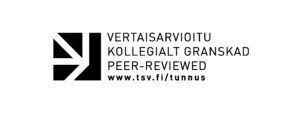Abstract
This study deals with the development of startup ideas and assessing the business models of the ideas created in an entrepreneurial hackathon. This study focuses on students’ perception of the attributes of a viable business model. There were eight coaches, who supported the student learning during the event by continuously coaching and organizing various activities for the students. The concept of business model was introduced to the students along with different aspects of the concept. The emphasis in this introduction was the utilization of Business Model Canvas, created by Osterwalder and Pigneur 2010. This study follows both quantitative and qualitative research methodology. For the purpose of data collection, a survey was developed. Empirical data was collected at the beginning of the hackathon. Our analysis shows that students see the value proposition and customer relationship being the most important attributes in a viable business model and the partner network being the least important one. All attributes were considered as somewhat important. Students also described a good business idea in an open-ended question. They indicated that the value proposition is a crucial part in a good business idea.
Keywords: Business model, entrepreneurship, higher education, business model canvas, business model attributes
1. Introduction
The concept of business model has gained considerable attention in the recent years by both academics and practitioners. Every business demands an ideal business model as an essential means for its survival, possible growth and success. The aim of the study is to explore the students’ perception of the attributes of a viable business model. According to McConnell et al. (2009), the business model is a simplified understanding of four key dimensions: “what should be produced”, “for whom it should be produced”, “which way it should be produced” and “with whom it should be produced”. Other scholars define business model as the structure for creating, delivering and capturing value for the organization (Casadesus-Masanell & Ricart, 2010; Osterwalder & Pigneur, 2010; Zott et al., 2011). The Business Model Canvas (BMC) tool, developed by Osterwalder and Pigneur (2010) discusses the nine dimensions that cover the three ideas of business model definition: i) creation of value (key partners, key activities, and key features); ii) delivery of value (channels, customer segment, and customer relationships); and iii) capture of value (cost structure and revenue structure) (Bonazzi & Zilber, 2014).
Many authors (e.g. Chesbrough, 2010; Zott et. al, 2011) mention the value proposition being a vital part of a business model. Zott et. al (2011) emphasize that e.g. a revenue model and network of relationships should be parts of the business model.
Business model can also be crucial to the success or failure of a company (e.g. Chesbrough, 2010; Luomakoski, 2012: Ahokangas & Myllykoski, 2014). A good business model can be more important than the product/service itself. One business model does not work for all companies even within a specific field of business.
Recognizing the attributes of a viable business model is one of the most important skills that the entrepreneurs need to acquire. Research shows that university graduates have shown a great potential to pursue entrepreneurship (Venesaar et al., 2007). For this reason, the higher educational institutions are trying their best to develop entrepreneurial competencies of university students through varied learning methods. Furthermore, it is important that the future entrepreneurs acquire business acumen and become aware of various important attributes of a business model. They need to recognize the importance of creating, delivering and capturing value for the organization and once they embark on their entrepreneurial journey, they are cognizant of their needs and requirements. In the same vein, this study investigates students’ perception of the attributes of a viable business model and the aims of this study is to identify the most important components of a business model according to the viewpoint of students.
We argue that understanding how students comprehend the whole entrepreneurial process is of utmost importance. While developing training programs and curricula from the entrepreneurship viewpoint, educators need proficiency in understanding the entrepreneurial process as it is not a linear one. They need to be equipped with as much understanding of this process as possible. After all, entrepreneurial education is a continuous learning process, where each person involved needs to constantly develop his/her entrepreneurial competencies. The main contribution of this study is that it offers an insight into the minds of the students and provides guidance to such educators, counsellors and trainers, who offer entrepreneurial education to the university students.
2. Methodology
2.1. Entrepreneurial Hackathon
This study focusses on students’ perception of the attributes of a viable business model. The data for this study comes from an entrepreneurial hackathon, which saw the participation of 81 international students. Seventy-two male and female students form the sample for this study, out of which the majority (69) belonged to the undergraduate degree programs and three were master’s level students. Further, there were eight coaches, who supported the student learning during the event by continuously coaching and organizing various activities for the students.
The hackathon was organized for two days as a 22-hour cruise in the Baltic Sea in October 2019. The aim of the hackathon was to gather interdisciplinary students together in order to generate business ideas, which could result into viable business models at a later stage. During the hackathon, the students were divided into small teams of 3-5 students, who received coaching from 8 coaches during the entire event. The coaches had the responsibility to design activities and introduce various business management tools that would guide the student teams during this innovation process. By the end of the event, each student team generated a novel business idea and got the opportunity to present the idea to other student teams and a jury of judges.
2.2. Mixed method study
This study utilizes a mixed method approach as both qualitative and quantitative data have been collected to study the students’ views and opinions of a viable business model.
By combining the two approaches, the researchers were able to bring more depth to the study as each method brought clarity and insight to the other (Burns et al., 2014).
The questionnaire developed for this study consists of two major parts. The first part included demographic data and questions measuring attributes of viable business model and the second part consisted of open-ended questions, which gave an opportunity to the participants to express their ideas. The quantitative part of the questionnaire mostly consisted of questions that were designed to assess the importance of various attributes based on a Likert scale from the “least important” (1) to the “most important” (5). Nominal scales were mainly used to study the demographics of the respondents.
The items for the questionnaire were operationalized based on a literature review (see e.g. Osterwalder and Pigneur 2010). In order to maximize the validity and reliability of the study, existing measurements have been used. The researchers reviewed and revised the questionnaire a couple of times. The researchers critically analyzed each item and added few more items, which resulted in minor changes to the presentation of the questionnaire. Keeping in view the ethical standards, the researchers obtained the consent of the participants prior to collecting the research data.
The empirical quantitative data was entered into IBM SPSS statistical tool. The data analysis was carried out by applying Mann-Whitney U test in case of two independent samples and Kruskal-Wallis test in case of three independent samples. Statistically significant findings in the Kruskal-Wallis test were further analyzed with Dunn’s post hoc test to study pairwise comparisons.
The qualitative data was arranged into categories and analyzed using MS Excel. After categorizing the data, connections were formed between categories and relationships were identified. For the purpose of qualitative analysis, the direct content approach is applied, which helps the researchers to validate the theoretical concepts (Hsieh & Shannon, 2005). The selection of analysis approach is in line with the aim of the study.
3. Results
The students assessed different attributes of a viable business model on a scale of least important (1) to most important (5) attribute. The most important attributes were ‘value proposition’ and ‘customer relationship’. The lowest importance was assessed on the attribute ‘partner network’. However, all the attributes were assessed to be somewhat important. (Figure 1.)

The students were divided into three categories based on their prior education and education in the area of entrepreneurship. The first group consisted of students that have no entrepreneurial education or experience. The second group had entrepreneurial education but no practical experience and last group had both entrepreneurial education and experience. (Table 1.)
| Frequency | Percent | |
| No education or experience | 7 | 9,7 % |
| Education but no experience | 43 | 59,7 % |
| Education and experience | 22 | 30,6 % |
| Total | 72 | 100,0 % |
The three groups’ assessment of the importance of each attribute was analyzed with Kruskal-Wallis test. The assessment of the ‘value proposition’ was the only attribute, where there were statistically significant differences between the student groups (H(2) = 10.621, p = 0.005, table 2).
| Value Proposition | |
| Kruskal-Wallis H | 10,621a |
| df | 2 |
| Asymp. Sig. | 0,005 |
aGrouping variable: Educational education and experience
Further pairwise comparisons with Dunn’s post hoc test indicate that students with both entrepreneurial education and experience assessed the importance of value proposition clearly higher than students that have only entrepreneurial education (p = 0.008, adjusted with Bonferroni correction). (Figure 2.)
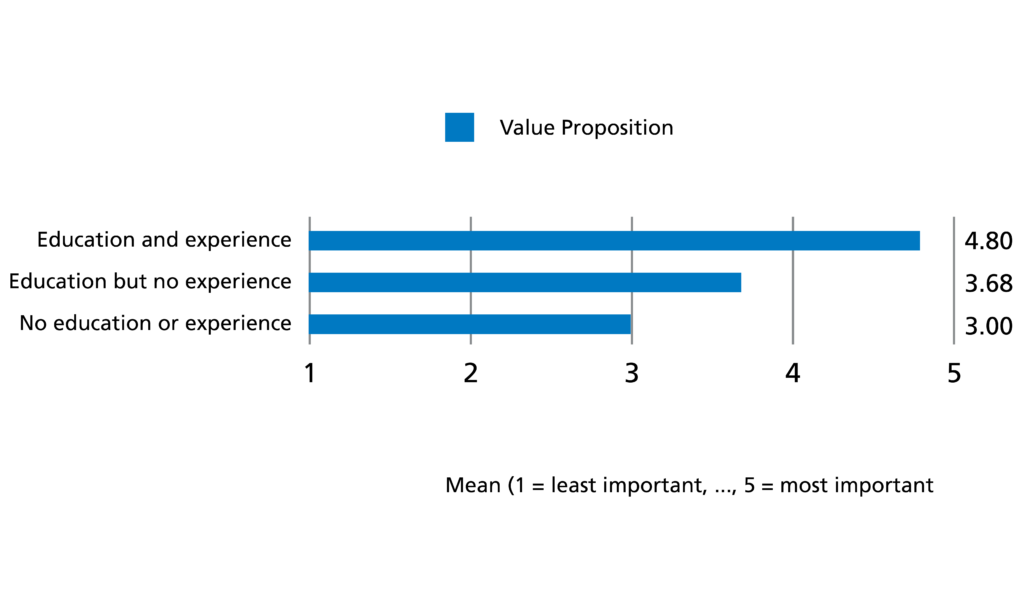
The students’ field of study has affected on their assessment of importance of the attributes of ‘value proposition’ and ‘distribution channel’.
The differences in the assessments of the importance of each attribute was analyzed with Kruskal-Wallis test. The differences of the assessment of the ‘value proposition’ were statistically significant between the students’ field of study (H(2) = 11.317, p = 0.003, table 3).
| Value Proposition | |
| Kruskal-Wallis H | 11,317a |
| df | 2 |
| Asymp. Sig. | 0,003 |
aGrouping variable: Field of study
Further pairwise comparisons with Dunn’s post hoc test indicate that Hospitality and wellness students assessed the importance of value proposition clearly lower than Business students (p = 0.013, adjusted with Bonferroni correction) and Information technology students (p = 0.003, adjusted with Bonferroni correction). (Figure 3.)
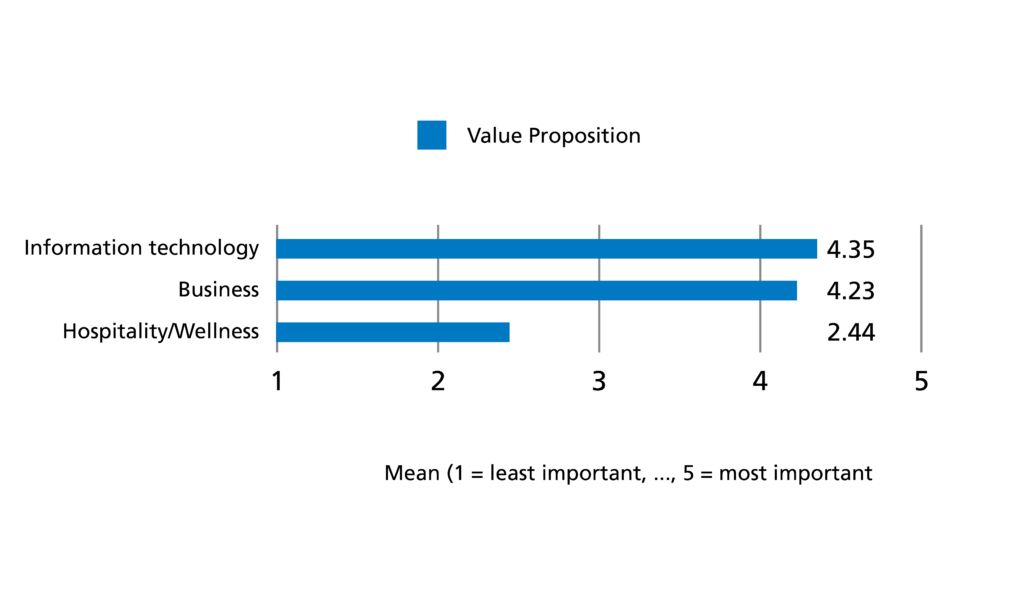
The differences in assessment of the distribution channels’ importance were statistically significant between Hospitality and wellness students and Business students. The Hospitality and wellness students assessed the distribution channels’ importance lower than Business students (p = 0.050, adjusted with Bonferroni correction, Figure 4).
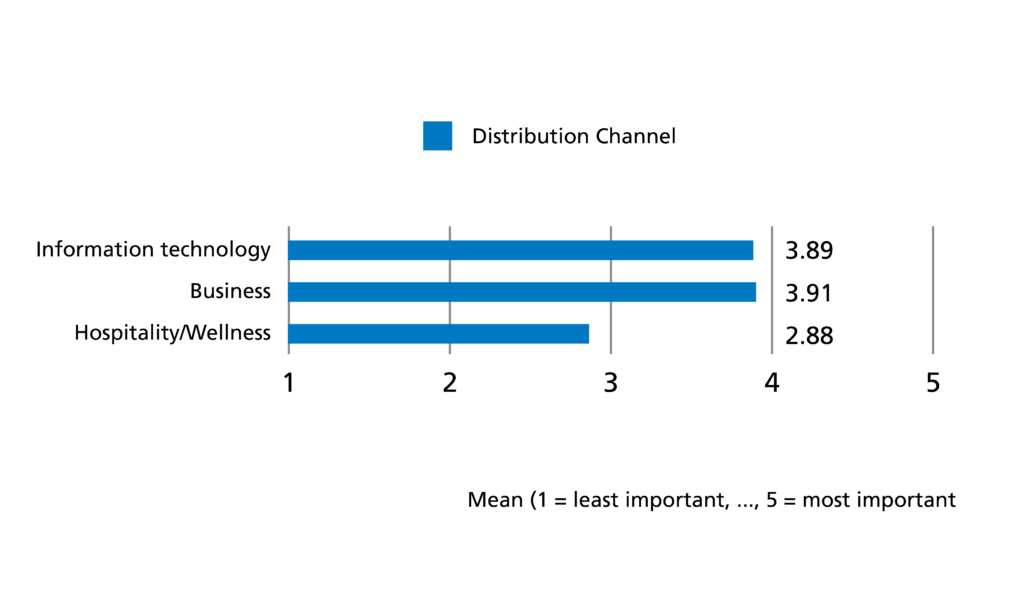
In two attributes, ‘key activities’ and ‘key resources’, there were statistically significant differences found between male and female students. The differences were analyzed with the Mann Whitney U test (Table 4).
| Key Activities | Key Resources | |
| Mann Whitney U | 498,500a | 447,500a |
| Asymp. Sig. | 0,002 | 0,023 |
aGrouping variable: Gender
Female students assessed the importance of both the ‘key activities’ (U = 498,500, Sig.=0,002) and ‘the key resources’ (U = 447,500, Sig.=0,023) of these attributes higher than male students. (Figure 5.)
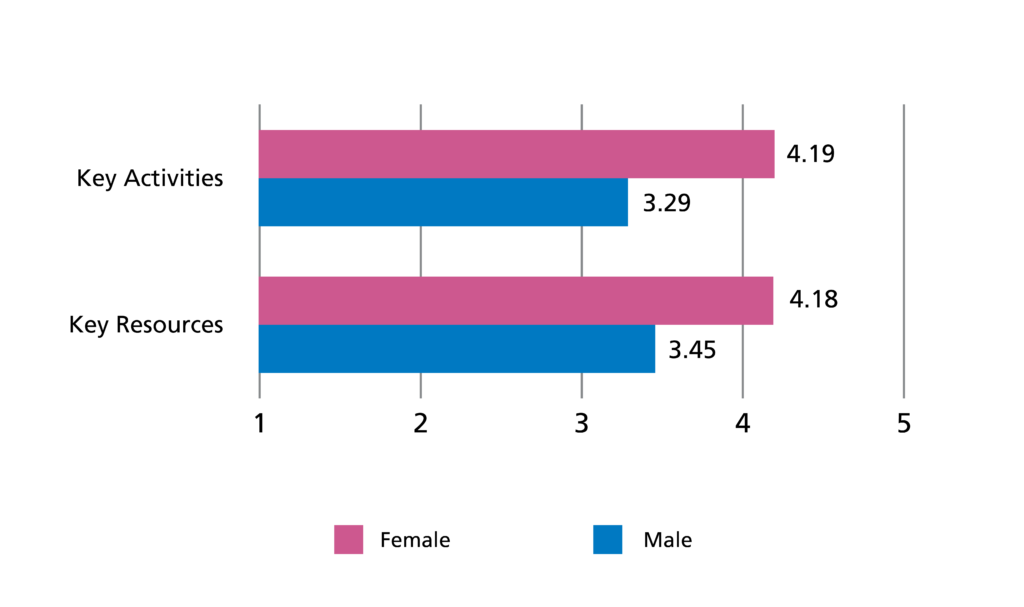
Out of the students that participated in the hackathon, 38,9 % (n = 28) have a business idea (for their own start-up). Having a business idea has affected on the assessment of importance of ‘customer segmentation’. The differences in the assessments were analyzed with the Mann Whitney U test (Table 5).
| Customer segmentation | |
| Mann Whitney U | 274,500a |
| Asymp. Sig. | 0,042 |
aGrouping variable: Business Idea
The students with a business idea, have assessed the importance of ‘customer segmentation’ higher compared to students that do not have an idea (U = 274,500, Sig.=0,042, Figure 6). The analysis shows that there is a clear difference between the students who have an idea versus to those who do not have an idea.
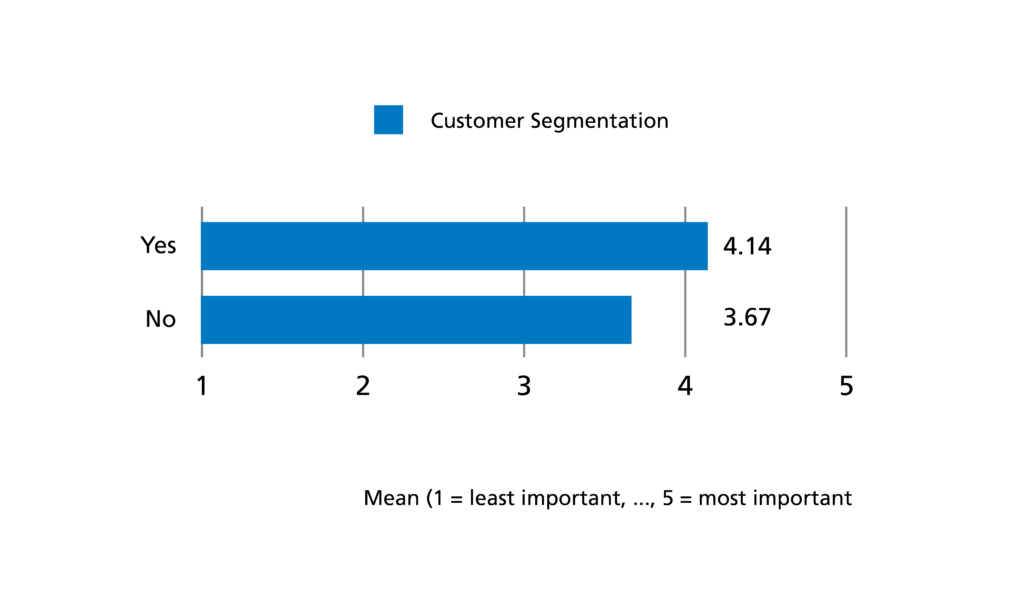
segmentation’ based on having a business idea
Qualitative analysis is based on an open-ended question, where the students were asked to describe a good business idea. We utilized content analysis, where we picked terms used by the students and counted how many different students had mentioned the respective term or its synonym. Out of 58 students, who replied to this question, 19 mentioned the ‘innovativeness’ of the idea and 6 used the words ‘new’ or ‘different’. Six out of the 19 students mentioned both ‘innovativeness’ and ‘newness’. This means that 43% of the students, who described a good business idea, considered the elements of ‘innovativeness’ and ‘newness’ to be important. Terms ‘customers’ or ‘customer needs’ were mentioned only in 8 of the 58 replies. Totally the students used over 30 different terms but most of them were mentioned only a few times.
4. Conclusions
This study presents a case of an entrepreneurial hackathon, where international students from a Finnish higher educational institution participated in the process of business idea generation and created numerous innovative, novel and sustainable business ideas. This study focuses on students’ perception of the attributes of a viable business idea. The results of the data analysis reveal that firstly, ‘value proposition’ and ‘customer relationships’ are considered the most important attributes of a viable business model. This is in line with previous research (e.g. Chesbrough, 2010; Zott et. al, 2011). The students also seem to see the importance of ‘key resources’, which was the third most important attribute in a viable business model. On the other hand, the students did see the ‘partner network’ the least important attribute. The importance of the ‘value proposition’ can clearly be seen by students, who have previous entrepreneurship education and especially with those who have also entrepreneurial experience. In addition, there was a clear difference between hospitality/wellness students versus business and information technology students, who perceived the ‘value proposition’ as a very important attribute in a viable business model.
There were also some differences between male and female students, namely in ‘key activities’ and ‘key resources’, where female students viewed them significantly higher than male students.
Based on the qualitative analysis students seem to value innovative and new types of business models. The concepts of customer and customer value were mentioned only eight times which might be related to the context of innovation hackathon and the emphasis of it to create new innovative ideas.
We suggest that in similar hackathons the coaches should emphasize also the importance of customers and customer value since without them an innovative idea has very limited commercial value.Since the number of students in the hackathon was limited, care should be taken in generalizing the findings of this study. Innovation hackathon seems to be an effective method of entrepreneurial education, a similar study could be conducted using a larger student sample.
Acknowledgements
The authors would like to express their gratitude to EU Interreg Central Baltic funded project NOCCA – Novel opportunities for new company creation and accelerated growth for providing the valuable research material and opportunity to conduct the research.
References
- Ahokangas, P., & Myllykoski, J. (2014). The Practice of Creating and Transforming a Business Model. Journal of Business Models, Vol. 2, No. 1, 6–18.
- Bonazzi, F., & Zilber, M. (2014). Innovation and business model: a case study about integration of innovation funnel and business model canvas. Review of Business Management, 16(53), 616–637.
- Burns, A. C., Bush, R. F., & Sinha, N. (2014). Marketing research. (7th ed.) Pearson Education.
- Casadesus-Masanell, R., & Ricart, J. E. (2010). From strategy to business model and to tactics. Long Range Planning, 43(2–3), 195–215.
- Chesbrough, H. (2009). Business Model Innovation: Opportunities and Barriers. Long Range Planning, 43(2010), 354–363.
- Hsieh, H. F., & Shannon, S. E. (2005). Three approaches to qualitative content analysis. Qualitative health research, 15(9), 1277–1288.
- Luomakoski, J. (2012). Why Did Electronic B2B Marketplaces Fail? Case Study of an Agricultural Commodity Exchange. (Doctoral Dissertation) Jyväskylä Studies in Business and Economics 115.
- McConnell, C., Brue, S., & Flynn, S. (2009). Economics: Principles, Problems, and Policies. McGraw-Hill.
- Osterwalder, A. (2004). The Business Model Ontology, A Proposition in a Design Science Approach. These Présentée à l’Ecole des Hautes Etudes Commerciales de l’Université de Lausanne. available at: http://www.hec.unil.ch/aosterwa/PhD/Osterwalder_PhD_BM_Ontology.pdf
- Osterwalder, A., & Pigneur, Y. (2010). Business model generation. John Wiley & Sons.
- Venesaar, U., Kolbre, E., & Piliste, T. (2007). Students’ attitudes and intentions toward entrepreneurship at Tallinn University of Technology. Working Paper 154, School of Economics and Business Administration at Tallinn University of Technology.
- Zott, C., Amit, R., & Massa, L. (2011). The business model: recent developments and future research. Journal of Management, 37(4), 1019–1042.
